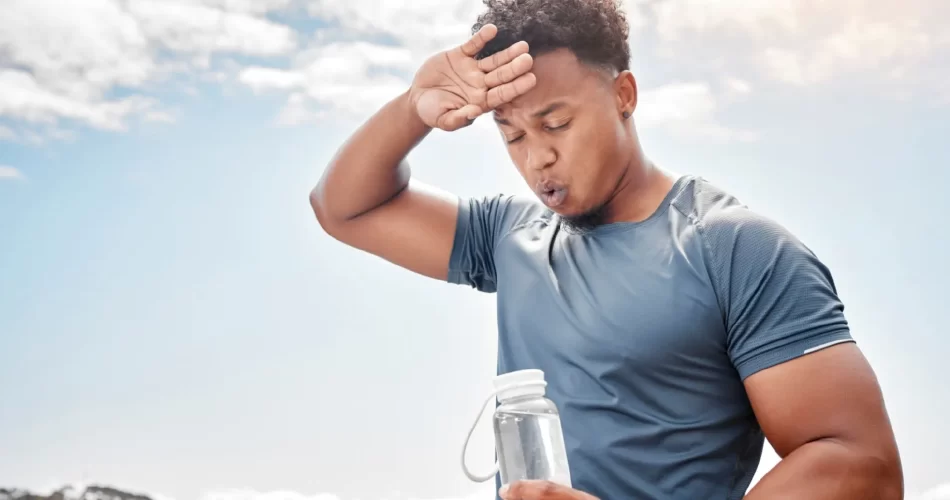Last Updated on 29 January 2024 by Vanessa Thoko
Physical activity has a number of benefits for your mental health, including:
- Reduced stress and anxiety
- Improved mood and self-esteem
- Better sleep
- Increased energy levels
- Improved cognitive function
In today’s fast-paced world, mental health has become a hot topic, and for good reason.
We’re living in a time where stress, anxiety, and depression are all too common.
But did you know that one powerful tool for boosting your mental well-being is right at your feet?
Yes, it’s physical activity! In this post, we’re diving into the amazing ways that breaking a sweat can help you feel better in your mind, body, and soul.
Quick Summary
- Benefits for Mental Health: Physical activity reduces stress, improves mood, self-esteem, sleep, energy levels, and cognitive function.
- Specific Mental Health Benefits: Exercise reduces depression and anxiety symptoms, improves mood, reduces stress, and boosts confidence.
- Types of Physical Activity: Aerobic, strength training, and mind-body exercises offer choices for everyone.
- Social Connection: Exercising with others enhances motivation and reduces loneliness.
- Additional Factors: Exercise improves sleep, brainpower, prevents chronic diseases, and helps maintain a healthy weight.
- Overcoming Barriers: Tips include finding enjoyable activities, setting goals, starting slowly, and seeking support.
The Science Behind It

When you exercise, your brain releases endorphins, which have mood-boosting and pain-relieving effects.
Exercise also helps to reduce stress hormones, such as cortisol.
And, just like any other muscle in your body, your brain needs exercise to stay healthy and function at its best.
Specific Mental Health Benefits

- Reduced symptoms of depression and anxiety: Exercise can help to improve mood, reduce negative thoughts, and increase energy levels. This can be especially beneficial for people with depression and anxiety.
- Improved mood: Exercise releases endorphins, which have mood-boosting effects. It also helps to reduce stress and improve sleep quality, which can lead to a better overall mood.
- Reduced stress: Exercise helps to reduce stress hormones, such as cortisol. It also provides a distraction from worries and can help to improve coping skills.
- Increased confidence: Exercise can help to improve body image and self-esteem. It can also give people a sense of accomplishment and help them to feel more in control of their lives.
Types of Physical Activity

There are many different types of physical activity, so you can find something that you enjoy and that fits into your lifestyle.
Some examples include:
- Aerobic exercise: This type of exercise gets your heart rate up and your blood flowing. Examples include running, swimming, biking, and dancing.
- Strength training: This type of exercise builds muscle strength and endurance. Examples include lifting weights, using resistance bands, and doing bodyweight exercises, such as push-ups and sit-ups.
- Mind-body exercise: This type of exercise combines physical movement with mental focus and relaxation. Examples include yoga, tai chi, and Pilates.
Social Connection

Exercising with friends or family can be more fun and motivating.
It can also help to reduce loneliness and isolation.
If you’re not sure where to start, there are many fitness classes and groups available.
Additional Factors
In addition to the mental health benefits listed above, exercise can also:
- Improve sleep quality
- Boost brainpower and memory
- Reduce the risk of chronic diseases, such as heart disease, stroke, and type 2 diabetes
- Help to maintain a healthy weight
Overcoming Barriers

Here are some tips for overcoming barriers to exercise:
- Find an activity that you enjoy and that fits into your lifestyle.
- Set realistic goals.
- Start slowly and gradually increase the amount of time you spend exercising each week.
- Find a workout buddy or join a class.
- Make exercise a part of your routine.
- Schedule time for exercise in your calendar.
- Keep track of your progress and celebrate your successes.
If you have any health concerns, be sure to talk to your doctor before starting a new exercise program.
How Active Do I Need To Be?
The level of physical activity needed for optimal mental health can vary from person to person.
However, experts generally recommend at least 150 minutes of moderate aerobic activity or 75 minutes of vigorous aerobic activity per week, along with muscle-strengthening activities on two or more days a week.
This could include activities like brisk walking, running, swimming, dancing, or cycling, coupled with exercises that work major muscle groups.
That said, finding the right level of activity isn’t just about meeting a specific quota. It’s also about finding what works best for you and what you enjoy.
Some people find that daily walks or yoga greatly benefit their mental health, while others prefer high-intensity workouts or team sports.
Experiment with different activities and frequencies to find what makes you feel good physically and mentally. Additionally, it’s important to consider factors like sleep, nutrition, stress management, and social connections, as they all contribute to overall mental well-being.
Things To Consider Before Getting Started
Before starting any new physical activity regimen, there are several important factors to consider for your safety and success:
- Health Assessment: If you have any health concerns or pre-existing conditions, it’s wise to consult a healthcare professional before beginning a new exercise program. They can provide guidance tailored to your specific health needs.
- Fitness Level: Assess your current fitness level realistically. Start gradually and progress slowly to prevent injuries. If you’re new to exercise, start with low-intensity activities and gradually increase the intensity and duration as your fitness improves.
- Goals: Define your goals. Whether it’s improving overall health, losing weight, gaining strength, or reducing stress, having clear objectives will help shape your workout routine.
- Types of Exercise: Consider different types of exercise that you enjoy and that fit your lifestyle. It could be aerobic exercises (like walking, swimming, or cycling), strength training, flexibility exercises (like yoga or stretching), or a combination of these.
- Schedule: Plan your workouts according to your schedule and commitments. Consistency is key, so find a realistic time that works for you to exercise regularly.
- Safety Precautions: Ensure you have appropriate gear and equipment for your chosen activities. Proper footwear, clothing, and safety equipment are important. Also, learn about proper technique to prevent injuries.
- Listen to Your Body: Pay attention to how your body responds to exercise. If you experience pain, dizziness, or discomfort, stop and assess whether you need medical attention or if you’re pushing too hard.
- Rest and Recovery: Don’t overlook the importance of rest days. Your body needs time to recover and adapt to exercise. Rest allows muscles to repair and grow stronger.
- Nutrition and Hydration: A balanced diet and proper hydration are crucial for supporting your exercise routine. Fuel your body with the nutrients it needs to perform well.
- Mindset: Approach exercise with a positive mindset. Enjoy the process and focus on how it makes you feel, both mentally and physically.
Conclusion
In a nutshell, physical activity isn’t just about getting fit; it’s about feeling good, mentally and emotionally.
So, lace up those sneakers, grab a friend, and start enjoying the mental health perks that exercise has to offer.
Your mind will thank you! Remember, taking care of your mental health is a journey, and it starts with that first step, or in this case, that first stride.










